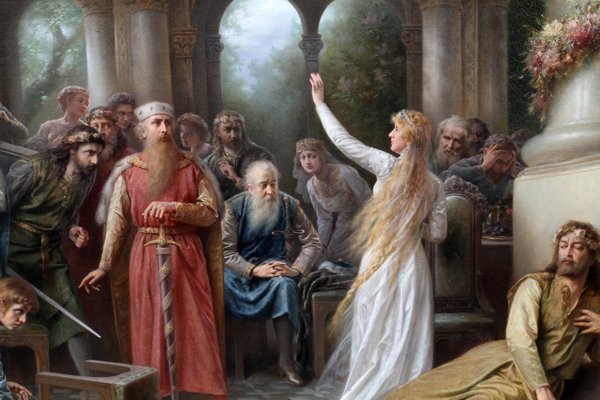Kings of the Kells
An incredibly old tale in the land of Keller, Kings of the Kells tells of harrowing origins of the Children of Keller and their settlement in Eiren by following the kings of the first five tribes.
It was first told verbally in different aspects, until compiled into a complete tale by the bard Blondel of Weawich, sometime in the 40th century into the language of Old Common.
Summary
The legend begins with a chronology of the tribes of the Children of Keller when they first landed in Eiren in the first millennium of the first age. The most prominent of these is the Tribe of Oncett, the youngest brother of the Kellerite tribe. The tribes are separated into six prominent clans, by eldest to youngest: Idnearth, Gweith, Myrick, Carannog, Arthwys, and Oncett. All of them are given blessings from their father Keller, save Oncett.
The first section of the book discusses the first king of the Kells, Morak Idnearthson. Morak becomes king after slaying the descendant of Kuchall, Gilach. Morak is deemed the Lord of Might. He then has a dream from the legendary Lady of the Lake, telling him the coming of the "short men". The dwarves of Bolderun do indeed come, but Morak, in his haughtiness, demands they tell the Kells where they came from and to share their goods. The dwarves, insulted, escape in the dead of night. Morak gains his just deserts, being slain and eaten by the dragon Gilach-Son. The dragons once again become king over the the Kells.
The second section shows the rise of the sons of Gweith, with their chieftain named Cradoc Gweithson. He delivers the Kells from their lord, the evil Culenk, by stabbing the lord in their sleep. He brings peace to the Kells for a few decades, and orders them to create great ships like the dwarves built. However, when testing their expedition, he becomes hasty and wishes to go on the first ship. Cradoc is killed in a mighty storm. Thus, a new lord rules the Kells and dominates them.
The third section shows the sons of Myrick turning on the Kells in favor of the dragons. King Dirk Myrick becomes a dragonlord, serving the evil Gilach-Son, and gaining a share of his wealth. However, a rebellious Myrickian named Arthur kills King Dirk in a duel and orders the other tribes to strike down his traitorous brethren. The tribe of Mywick thus gets destroyed, starting anew with Arthur Mywick and his children. However, Arthur proves to not be strong enough to stand against Gilach-Son, and thus they are ruled by the tyrant for another decade.
In the fourth section, the children of Carannog aspire for greatness and contact the Amagus in the swamps of Chunc. He orders them to build ships like the Dwarves and not to mistreat them. The head of the expedition would be the wizard Saewine Carannog. In the cover of the coastline's caves, the Kells united against and built their ships. Before Gilach-Son could stop them, they traveled across the ocean and met great storms. Imbued with his magical powers, Saewine calmed the storms. They safely arrive in Eiren ("Paradise" in the ancient Kellerite tongue). Seawine leads the people for a few years, but at the end of the legend he dies from the stress of trying to stop a blood fued. The Kells return to being dis-unified and are attacked by Orc tribes. The Tribe of Carannog was captured by the orcs and intermingled. Hence why many Half-Orcs are found within the tribe of Carannog.
The last section has the tribes united under the children of Arthwys. Feldric Arthwys becomes the King of the Kells and meets the Dwarven King, who teaches them the mysteries of writing and iron. Feldric Arthwys abandons his worship of Morganine, becoming enlightened by Boldur, and leads the Kells to greatness. At the height of his reign, he forms a great city, called Keller's Coast. However, he dies without an heir apparent, and the tribes of Keller descend into blood feud again.
The epilogue of the legend calls to the children of Oncett, acknowledging they were left with no blessing, and commands them to show their worth on their own.
Cultural Reception
The House of Oncett's descendants were primarily concerned with keeping the legends intact and accurate as possible. It has been held close to their hearts. Oncetts throughout history figured their true blessing was their freedom. In recent history, the House of Oncett intermingled with the House of Ebenwald, Kings of Lysandus. The House of Oncett, with the king on the throne, views the position to be their missing blessing, much to the chagrin of other the other Kellerite families.
Date of First Recording
Around the 40th Century, first age.
Date of Setting
Around the beginning of the first millenium, first age.
Remove these ads. Join the Worldbuilders Guild




Comments